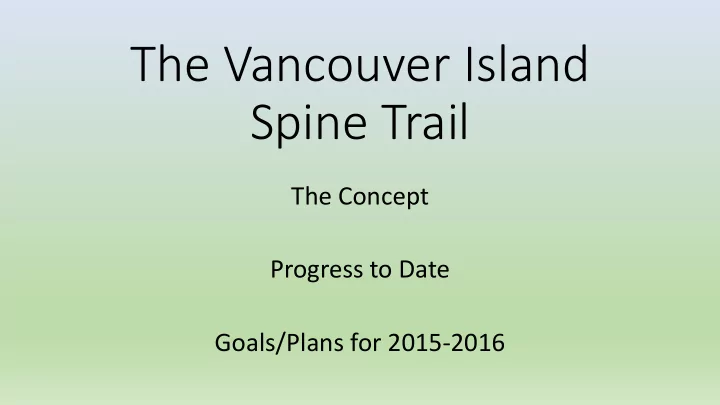

The Vancouver Island Spine Trail The Concept Progress to Date Goals/Plans for 2015-2016
The VI Spine Trail Concept • Continuous trail from Victoria to Cape Scott • A non-motorized trail for a range of users – hikers, mountain bikers, equestrians (but not all in all places) • Linking existing trails where possible • A “wilderness trail” • In the sense of few facilities, little support, often remote • But recognizing it includes both ‘protected area’ and ‘working forest’ • A “light trail” – mostly brush cleared, windfalls cut, little excavation • Also using old roads (some active) as available
The VI Spine Trail Concept • Overview of the Proposed trail: • 700 km • need buy-in from stakeholders
The VI Spine Trail Progress • Progress to date: • in green • 400 km
The VI Spine Trail – 2015-16 • Goals/Plans for 2015-2016 • emphasis north of Campbell River • across Crown lands • First Nations agreement & involvement – Kwakiutl, ‘Namgis & Nanwakolas • Working forest – mainly Western Forest Products • continue efforts with RD’s in south re access to Private lands • Trans-Canada Trail – Malahat section
The VI Spine Trail – 2015-16 • Suquash, Kilpala, Holdsworth & Bonanza sections
The VI Spine Trail – 2015-16 • Four northern sections: • Current thinking shown; could well/probably will change • Suquash and Kilpala are first priority • Holdsworth & Bonanza are lower priority • Contingent on First Nations agreement • Contingent on funding – grant applications to BC Hydro, MEC, FMCBC
The VI Spine Trail – 2015-16 (- colors as indicated on following images) SECTION Existing Trail New Trail Road OK as is Road needs shown in green in yellow in red brushing - marking & gps - location & flagging - marking & gps in orange - clearing - road brushing - marking & gps - marking & gps Suquash 6.5 7.4 19.7 (?) - Kilpala 0.2 2.0 18.2 1.0 Holdsworth - 10.5 20.1 - Bonanza - 26.6 5.8 -
The VI Spine Trail – 2015-16 - Suquash section
The VI Spine Trail – 2015-16 - Kilpala section
Working Forests – Management approach • ‘light’ trail as envisaged does not need S. 56 – MFLNRO • legal status only needed for more developed trail sections • liaison (developing) with forest tenure holders - a ‘co - existence’ approach • on-going dialogue & communication (e.g. WFP - web enabled) • facilitated by current small cutblocks with internal reserves • temporary closures & trail relocation as needed
What does a “light trail” look like? - higher elevation forest - semi-open subalpine
What does a “light trail” look like ? - marking important for socked-in conditions
Linking Cumberland to the Beaufort Crest
Linking Cumberland to the Beaufort Crest • Cleared (green line) to 1,000 metre level (this week)
Linking Cumberland to the Beaufort Crest
Linking Cumberland to the Beaufort Crest - Upper Trent crossing (Dave Silver photo on left)
Recommend
More recommend